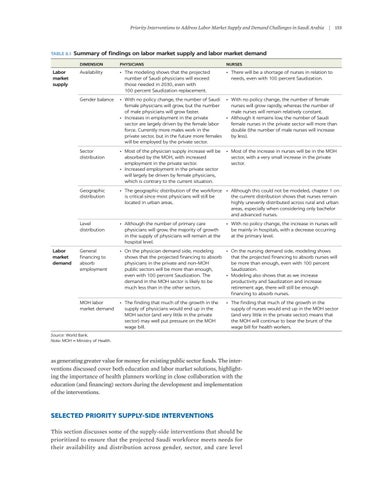Priority Interventions to Address Labor Market Supply and Demand Challenges in Saudi Arabia | 155
TABLE 8.1 Summary
Labor market supply
Labor market demand
of findings on labor market supply and labor market demand
DIMENSION
PHYSICIANS
NURSES
Availability
• The modeling shows that the projected number of Saudi physicians will exceed those needed in 2030, even with 100 percent Saudization replacement.
• There will be a shortage of nurses in relation to needs, even with 100 percent Saudization.
Gender balance
• With no policy change, the number of Saudi • With no policy change, the number of female female physicians will grow, but the number nurses will grow rapidly, whereas the number of of male physicians will grow faster. male nurses will remain relatively constant. • Increases in employment in the private • Although it remains low, the number of Saudi sector are largely driven by the female labor female nurses in the private sector will more than force. Currently more males work in the double (the number of male nurses will increase private sector, but in the future more females by less). will be employed by the private sector.
Sector distribution
• Most of the physician supply increase will be absorbed by the MOH, with increased employment in the private sector. • Increased employment in the private sector will largely be driven by female physicians, which is contrary to the current situation.
Geographic distribution
• The geographic distribution of the workforce • Although this could not be modeled, chapter 1 on is critical since most physicians will still be the current distribution shows that nurses remain located in urban areas. highly unevenly distributed across rural and urban areas, especially when considering only bachelor and advanced nurses.
Level distribution
• Although the number of primary care physicians will grow, the majority of growth in the supply of physicians will remain at the hospital level.
General financing to absorb employment
• On the physician demand side, modeling • On the nursing demand side, modeling shows shows that the projected financing to absorb that the projected financing to absorb nurses will physicians in the private and non-MOH be more than enough, even with 100 percent public sectors will be more than enough, Saudization. even with 100 percent Saudization. The • Modeling also shows that as we increase productivity and Saudization and increase demand in the MOH sector is likely to be retirement age, there will still be enough much less than in the other sectors. financing to absorb nurses.
MOH labor market demand
• The finding that much of the growth in the supply of physicians would end up in the MOH sector (and very little in the private sector) may well put pressure on the MOH wage bill.
• Most of the increase in nurses will be in the MOH sector, with a very small increase in the private sector.
• With no policy change, the increase in nurses will be mainly in hospitals, with a decrease occurring at the primary level.
• The finding that much of the growth in the supply of nurses would end up in the MOH sector (and very little in the private sector) means that the MOH will continue to bear the brunt of the wage bill for health workers.
Source: World Bank. Note: MOH = Ministry of Health.
as generating greater value for money for existing public sector funds. The interventions discussed cover both education and labor market solutions, highlighting the importance of health planners working in close collaboration with the education (and financing) sectors during the development and implementation of the interventions.
SELECTED PRIORITY SUPPLY-SIDE INTERVENTIONS This section discusses some of the supply-side interventions that should be prioritized to ensure that the projected Saudi workforce meets needs for their availability and distribution across gender, sector, and care level

